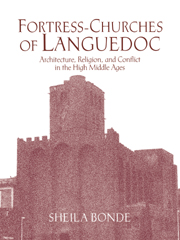Book contents
- Frontmatter
- Contents
- List of illustrations
- Acknowledgments
- Introduction
- 1 Ecclesiastical Fortification in the Middle Ages
- 2 The Larger Context: Languedoc in the Twelfth Century
- 3 The Buildings and the Documents: Maguelone, Agde, and Saint-Pons-de-Thomières
- 4 The Manning and Operation of Fortress-Churches
- 5 The Architectural Context: Sources and Parallels
- Conclusion
- Appendixes
- Tables
- Abbreviations
- Notes
- Bibliography
- Illustration credits
- Index
Conclusion
Published online by Cambridge University Press: 02 November 2009
- Frontmatter
- Contents
- List of illustrations
- Acknowledgments
- Introduction
- 1 Ecclesiastical Fortification in the Middle Ages
- 2 The Larger Context: Languedoc in the Twelfth Century
- 3 The Buildings and the Documents: Maguelone, Agde, and Saint-Pons-de-Thomières
- 4 The Manning and Operation of Fortress-Churches
- 5 The Architectural Context: Sources and Parallels
- Conclusion
- Appendixes
- Tables
- Abbreviations
- Notes
- Bibliography
- Illustration credits
- Index
Summary
The culture of medieval France was undoubtedly as complex and contradictory as our own. One of the primary tasks of the historian is to create a framework for keeping track of innumerable events, forms, and people and for mapping the complex interactions among these elements. This framework provides a structure by which we organize and – we hope – make sense of a past that can be similar to our own experience but that can also be quite alien. The frame, however, can also become a limit to vision. For example, the failure of past historians of Western medieval Europe to consider aspects of the medieval East, the place of women, or the evidence of material culture have produced views of the Middle Ages we now see as flawed. Similarly, the conventional frame of architectural history has marginalized buildings in Languedoc that are unusual according to standards more appropriate to the north than to the south of France.
A close reading of the uses and meanings of the fortified church in Languedoc has forced us to reevaluate some of the canons of architectural history. The fortress-church has demanded that we integrate the study of military and ecclesiastical architecture, reconsider the motivations for a host of architectural forms, rescue Languedoc from its position as a provincial backwater, reexamine the links between medieval East and West and between the North and South, and reevaluate the stylistic concepts of Romanesque and Gothic.
Information
- Type
- Chapter
- Information
- Fortress-Churches of LanguedocArchitecture, Religion and Conflict in the High Middle Ages, pp. 173 - 176Publisher: Cambridge University PressPrint publication year: 1994
